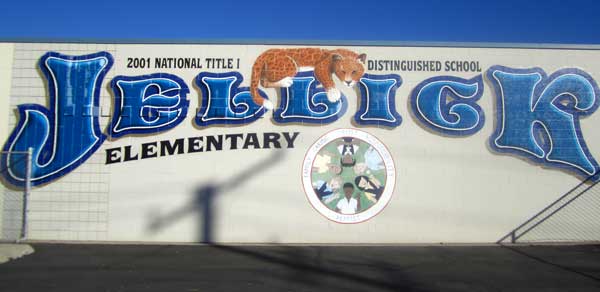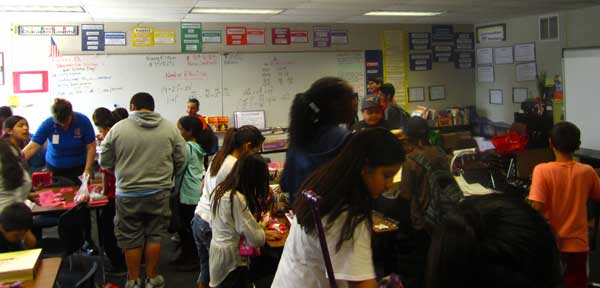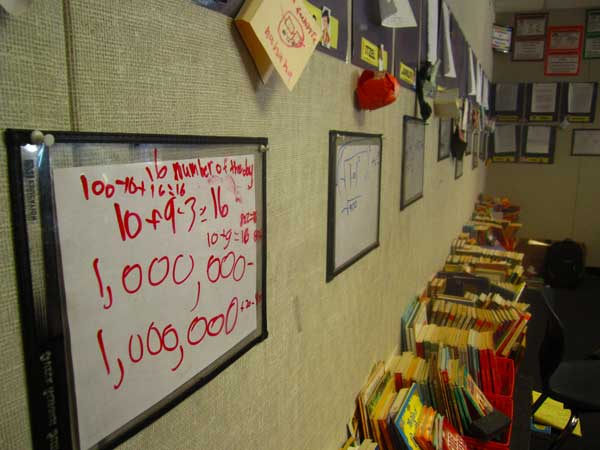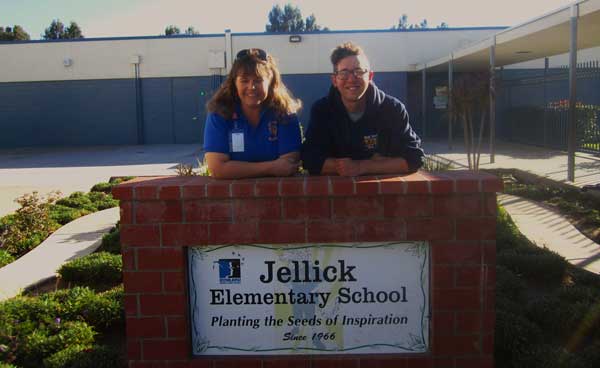Being from Chicago, I have never been to an elementary school in Southern California.
So, I was curious to see how some of the students I worked with at High Trails function in their California classroom. Jellick Elementary has been coming up here since 2003, all with the same dedicated teacher; Nancy Buck. This school seemed like a good candidate for a school visit.
 The Setting
The Setting
I made my way down the mountain, along the highway to Jellick Elementary. Driving through the neighborhood, I began to have a sense for where these students were from. Like most Southern California schools, hallways don’t exist between the buildings; everything opens to the outside environment. I walked my way through the courtyard to the back corner classroom. I was greeted by my old students and familiar faces.
Inside the classroom, the desks were put into 6 different groups with 5-6 students in each pod. Ms. Buck individually asked students if they were missing any materials for the next class in front of everyone. This gave accountability to the student to be prepared for class. For the next class, math, students had a textbook that they could write in.
 Guided Instruction
Guided Instruction
With introduction to a new topic, Ms. Buck prefaces that the textbook is at a high 6th grade level but encourages that they will be able to understand if focused. The subject started with students repeating the objective for the class: “I will write algebraic expressions to represent real world situations by changing words to correct terms.” She revisits this objective throughout class.
When approaching the first example, Ms. Buck states, “6th grades who can identify key words are working their way up the escalator.” After class she told me that this was in reference to this video. She uses this as a constant metaphor for students getting stuck and that their frustration clouds the solution. When underlining on the board, Ms. Buck uses multiple colors to highlight different examples and connect others.
 Independent Work
Independent Work
During individual work, Ms. Buck reminds students of their resources: previous examples, information from the problem and the people in your seating group. Group seating allows students to naturally check in and ask their neighbor for help if needed. She alerts students to common mistakes. She gives guided steps, walks around to see individual student understanding.
Ms. Buck checks in with most, if not all of her students, but puts her focus on the students who she knows need the most guidance on the first step. Using positive affirmation, she encourages students who have an understanding of the process.
As students start to drift, simply saying, “Eyes up.” is a simple way to refocus the entire class
With such a large class, Ms. Buck is quick to get her students attention. With call backs, something we use often at High Trails, she quickly gets the attention of the full class. As students start to drift, simply saying, “Eyes up.” is a simple way to refocus her entire class. When the students become too loud, after gaining their attention, Ms. Buck lowers her voice to set the example of the tone students should be talking at.
Assessment
An alarm sounded, but it wasn’t the end of class yet. Students got out of their desk and stood at small whiteboards around the room. Students were given a number of the day which they had to manipulate to represent the simple number in a complex way. This got students thinking about order of operations, different operations that they haven’t covered in their core curriculum. The idea for Math 360 comes from this video. This approach to math allows students to check with their neighbor’s work while also giving Ms. Buck a viewpoint of each student’s board.
 General Procedures
General Procedures
With the day running out, students, having a responsibility to clean up the classroom, quickly did their final tasks, packed their bags and headed out the door for the weekend. Throughout class, students had different jobs and responsibilities: answering the door, answering the phone, etc. This both deferred distractions but also gave students a responsible role in their classroom community.
 Take Home Message
Take Home Message
There were a lot of things I observed in the classroom that mirrored the teaching techniques I use in the outdoor classroom. It was helpful to see what students have a familiarity with and what is different from the outdoor classroom, other than ascetics. I am headed in the direction of mathematics classroom teaching and this class was great to observe because it allowed me to reflect on how I teach now, as well as possibilities for my future. Thank you, Mrs. Buck!
At High Trails Outdoor Science School, we literally force our instructors to write about elementary outdoor education, teaching outside, learning outside, our dirty classroom (the forest…gosh), environmental science, outdoor science, and all other tree hugging student and kid loving things that keep us engaged, passionate, driven, loving our job, digging our life, and spreading the word to anyone whose attention we can hold for long enough to actually make it through reading this entire sentence. Whew…. www.dirtyclassroom.com

Comments are closed.